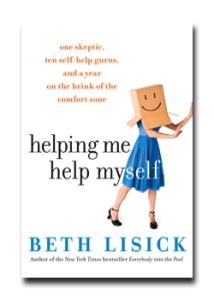 I just finished reading the best book, a book that had me snarfing milk out my nose as I read it at the breakfast table. I know, it’s rude to read at the table, but so be it.
I just finished reading the best book, a book that had me snarfing milk out my nose as I read it at the breakfast table. I know, it’s rude to read at the table, but so be it.
Beth Lisick lays her cards right on the table in the introduction of Helping Me Help Myself: One Skeptic, Ten Self-Help Gurus, and a Year on the Brink of the Comfort Zone. She writes:
I’d gone through my whole life being okay with being okay. And though I’d never read a self-help book before this year, I always liked picturing a world where the self-help movement had ended right there, with everyone feeling overwhelmingly, satisfyingly okay. . .
. . .[H]ow does a skeptic dive into the world of self-help?
I know I’m not alone on this. Surely my friends and I weren’t the only people who used to sit around at 2:00 a.m. watching Tony Robbins informercials for amusement.
But dive in she does, for reasons I’ll let you discover in your own reading. Lisick takes twelve months to test the waters of various aspects of self-helpdom, giving each a one-month trial. She samples the business coaching of Stephen Covey (The Seven Habits of Highly Effective People); the Venus/Mars relationship advice of John Gray, and the fitness whirlwind approach of Richard Simmons, to name but a few.
What I loved about Lisick’s writing in this book was her unflinching honesty about herself. When she goes to a Suze Orman seminar for financial help, Lisick writes:
I think about how Suze’s approach is extremely accessible to the average working joe, but how so many of her tips don’t compute in my world at all. She talks about “regular” expenditures like pet grooming, gym memberships, manicures, haircuts, and my favorite, window washing. I feel like if I could afford regular window washing, manicures, and haircuts, I might as well also own a yacht.
But what made me revere Lisick and want to invite her and her family over to hang out was her determination to avoid giving in to her preconceptions, either about the self-help millionaires or their target audiences, until she’d had a chance to know what the fuss was about. For example, when she tells her friends she’s going to go on a Richard Simmons “Cruise to Lose” week, most of them ask how she’s going to deal being on a ship with a “bunch of fat people from Middle America?” She writes:
It’s not that I’m trying to protect anyone’s feelings, really, but my first thought is: Will there ever be a day when people stop using the phrase “middle America” as code for “unattractive, fat, white, conservative people with bad clothes”? Did I leave anything out? Sheeplike. Trashy. Dumb. Christian. Any why are they so sure that’s who’s going to be there? Part of me wants to sign up for the cruise just to prove everyone wrong.
Do yourself an enormous favor and read this book. You’ll feel better from laughing, and may even learn a thing or two.







